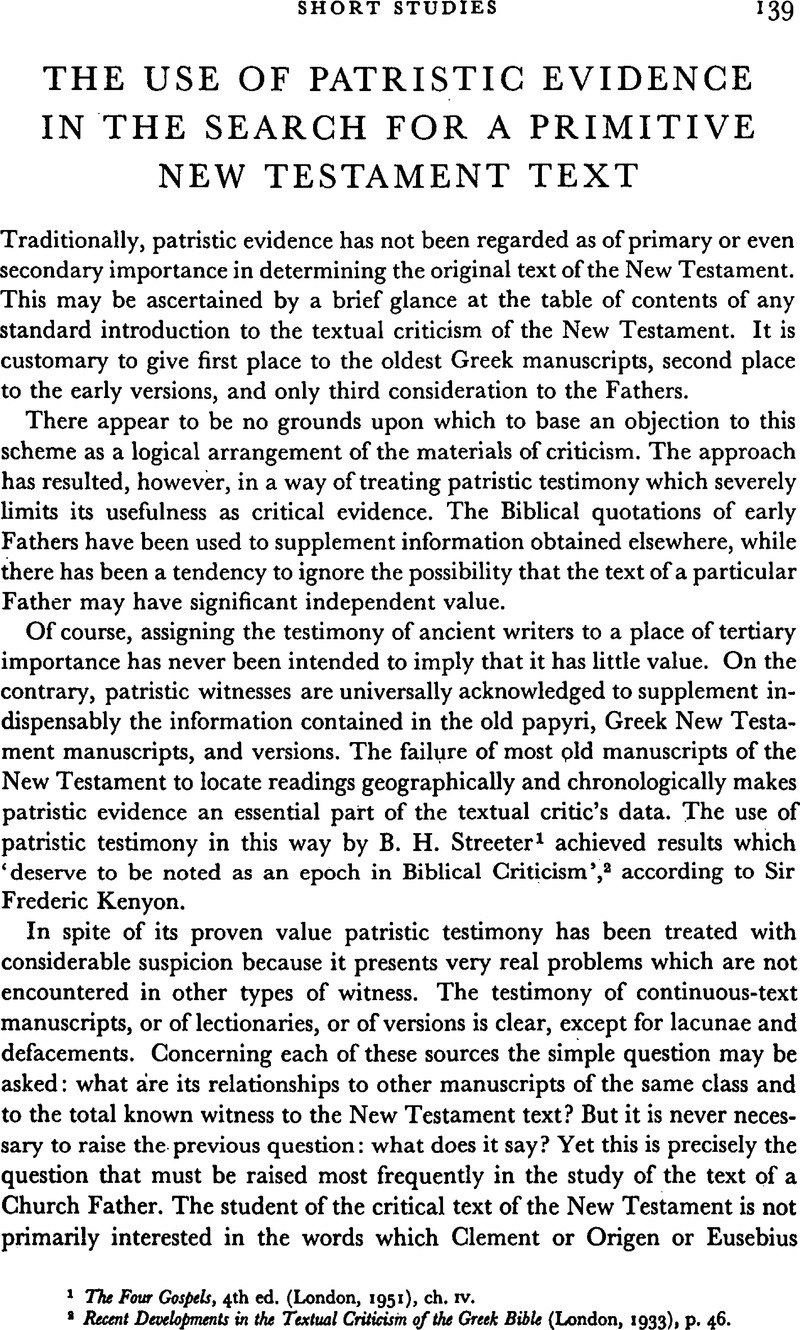Published online by Cambridge University Press: 05 February 2009

page 139 note 1 The Four Gospels, 4the ed. (London, 1951), ch iv.Google Scholar
page 139 note 2 Recent Developments in the Textual Criticism of the Greek Bible (London, 1933), p. 46.Google Scholar
page 140 note 1 Westcott, B. F. and Hort, F. J. A., The New Testament in the Orginal Creek, Introduction and Appendix (Cambridge and London, 1882), ‘Introduction’, pp. 202–3.Google Scholar
page 141 note 1 A critical edition gives us confidence, but is not infallible. Its strongest guarantee is its apparatus, and reference must be made to the footnotes to examine the evidence in every instance. A simple example may be taken from Heikel's GCS edition of Eusebius' Tritennatsrede an Constantin (Eusebius Werke, 1, [page] 321, [line] 20). In a citation of John i. 3–4, a later scribe ‘corrected’ ![]() to read
to read ![]() . The modern editor accepted the emendation, which implies a punctuation different from that usually adopted by Eusebius. The apparatus shows the longer reading to be the editor's error and not an exception to Eusebius' regular form.Google Scholar
. The modern editor accepted the emendation, which implies a punctuation different from that usually adopted by Eusebius. The apparatus shows the longer reading to be the editor's error and not an exception to Eusebius' regular form.Google Scholar
page 141 note 2 Klostermann, Erich, GCS, Eusebius Werke, iv, 3. I, 3, 30; 6. 20.Google Scholar
page 142 note 1 Alterations of the Words of Jesus as Qjsoted in the Literature of the Second Century (Cambridge, Mass., 1952), p. 14.Google Scholar
page 143 note 1 See Bebb, J. M., ‘The Evidence of the Early Versions and Patristic Quotations on the Text of the New Testament’, Studia Biblica et Ecclesiastica, ii (1890), 216.Google Scholar
page 143 note 2 So Stevenson, J., Studies in Eusebius (Cambridge, 1929), p. 33. interprets Contra Marceltum, 30. 5.Google Scholar
page 143 note 3 Wallace-Hadrill, D. S., ‘An Analysis of Some Quotations from the First Gospel in Eusebius’ Demonstratio Euangelica’, Journal of Theological Studies, n.s. 1 (1950), 168–75.CrossRefGoogle Scholar
page 144 note 1 See Gregory, C. R., Textkritik des Neuen Testamentes (Leipzig, 1902), II, 753–4.Google Scholar
page 144 note 2 Clement's reading now has the support of ![]() 13 (OP 657).Google Scholar
13 (OP 657).Google Scholar
page 144 note 3 ‘The Eusebian Form of the Text Matth. 28. 19’, Zeitshrift für die neutestamentliche Wissenschaft, 11 (1901), 275–88.Google Scholar
page 144 note 4 ‘Three Early Doctrinal Modifications of the Text of the Gospels’, 1 (1902–1903), 96–113.Google Scholar
page 144 note 5 Ibid. p. 113.
page 144 note 6 ‘Critique Textuelle et Citations Patristiques’, LVII (1950), 388–408: ‘Lectio Brevior, Potior’, LVIII (1951), 161–8. See also the extensive use of the testimony of Fathers byGoogle ScholarWinter, Paul, ‘Matthew XI 27 and Luke X 22 from the First to the Fifth Century’, Novum Testamentum, 1 (1956), 112–48.CrossRefGoogle Scholar
page 145 note 1 See Metzger, Bruce M., ‘The Caesarean Text of the Gospels’, Jouinal of Biblical Literature, lxiv (1945), 457–89.CrossRefGoogle Scholar
page 145 note 2 ‘Some Recent Discoveries’, Religion in Life, V (1936), 92.Google Scholar
page 145 note 3 Ibid. pp. 89–102.
page 145 note 4 ‘Texto cesariense o pre-cesariense?’, Biblica, xvi (1935), 369–415.Google Scholar
page 146 note 1 ‘The Chester Beatty Papyrus and the Caesarean Text’, Journal of Theological Studies, XL (1939), 55.Google Scholar
page 146 note 2 An Introduaion to the Textual Criticism of the New Testament (Eng. tr., Miller, B. V., St Louis (1937)), pp. 116–21.Google Scholar
page 146 note 3 ‘Mark 6 and 11 in ![]() 45 and in the Caesarean Text’, Journal of Biblical Literature, lxxiv (1955), 262–71;Google Scholar and more extensively in A Critical Survey and Evaluation of the Earliest Greek Manuscripts of the new Testament (Unpublished Ph.D. dissertation, Duke University, 1949).Google Scholar
45 and in the Caesarean Text’, Journal of Biblical Literature, lxxiv (1955), 262–71;Google Scholar and more extensively in A Critical Survey and Evaluation of the Earliest Greek Manuscripts of the new Testament (Unpublished Ph.D. dissertation, Duke University, 1949).Google Scholar
page 146 note 4 See ‘Eusebius' Text of John in the “Writings against Marcellus”’, Journal of Biblical Literature, lxxv (1956), 137–42;Google Scholar‘The Eusebian Text of Matthew’’, Novum Testamentum, 1 (1956), 233–45;CrossRefGoogle ScholarThe New Testament Text of Eusebius of Caesarea (unpublished Ph.D. dissertation, Duke University, 1954). Much of the material in this article was taken from the latter source.Google Scholar
page 147 note 1 ‘The Biblical Text of Clement of Alexandria’, Texts and Studies, vol. v, no. v (Cambridge, 1899).Google Scholar
page 147 note 2 A partial reconstruction of the text of Eusebius was attempted in my The New Testament Text of Eusebius of Caesarea, pp. 169–360.Google Scholar